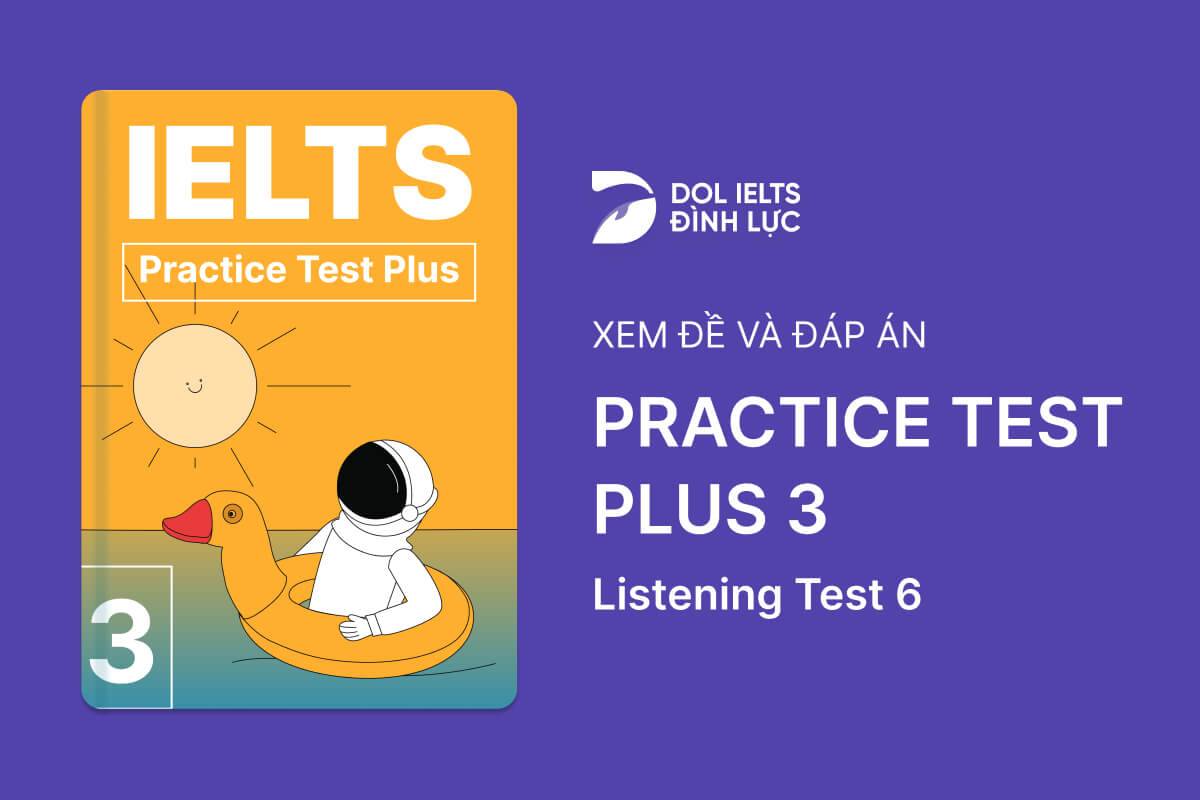Đề thi IELTS Online Test Practice Test Plus 3 - Listening Test 6 - Download PDF Câu hỏi, Transcript và Đáp án
Luyện tập đề IELTS Online Test Practice Test Plus 3 - Listening Test 6 được lấy từ cuốn sách Practice Test Plus 3 với trải nghiệm thi IELTS trên máy và giải thích đáp án chi tiết bằng Linearthinking, kèm answer key và list từ vựng IELTS cần học trong bài đọc.
Section
👂️ Bài nghe section 1
❓ Tapescript section 1
🔥 Đáp án & giải thích section 1
Giải thích chi tiết
Mình cần điền tên địa điểm (giống Kingfisher hay Sunnybanks ở các cột dưới)
 Đầu tiên, Liz nhắc tới tên một địa điểm là ''Well there’s a place near here called Moonfleet ...''
Đầu tiên, Liz nhắc tới tên một địa điểm là ''Well there’s a place near here called Moonfleet ...''
Sau đó Ken đánh vần là ''Is that M-double O- N-F-L-double E- T?'' và Liz xác nhận là đúng
=> Đáp án là Moonfleet 
Section
👂️ Bài nghe section 2
❓ Tapescript section 2
🔥 Đáp án & giải thích section 2
Giải thích chi tiết
Mình cần biết tại sao giờ là thời điểm tốt cho DIY painting
=> Đáp án sẽ có sau ''There’s never been a better time for people who like to do their own interior house painting.'' (Không có thời điểm nào tốt hơn để ...)
 Đầu tiên, ''Although people still lead very busy lives''
Đầu tiên, ''Although people still lead very busy lives''
=> Cuộc sống của mọi người vẫn bận rộn, tức là họ không có nhiều thời gian rảnh hơn
=> Loại đáp án C 
 Sau đó, ''thanks to the availability of various new DIY materials, you can now decorate your home in a more efficient and a more environmentally-friendly way.''
Sau đó, ''thanks to the availability of various new DIY materials, you can now decorate your home in a more efficient and a more environmentally-friendly way.''
=> Nhờ có nhiều vật liệu DIY mới, chúng ta có thể trang trí nhà một cách hiệu quả và thân thiện với môi trường hơn, hay nói ngắn gọn là chúng ta có sản phẩm DIY tốt hơn
=> Đáp án là A 
 Câu ở trên nói về material nhưng không nói về giá của chúng thay đổi ra sao
=> Loại đáp án B
Câu ở trên nói về material nhưng không nói về giá của chúng thay đổi ra sao
=> Loại đáp án B 
Section
👂️ Bài nghe section 3
❓ Tapescript section 3
🔥 Đáp án & giải thích section 3
Giải thích chi tiết
 Mình cần nghe xem tại sao Matthew muốn tham gia thực tập
Mình cần nghe xem tại sao Matthew muốn tham gia thực tập
=> Đáp án sẽ có sau ''I just wanted to talk to you about temporary work placements ...''
 Đầu tiên, ''I’ve got some savings, so I don’t really need the money at the moment.''
Đầu tiên, ''I’ve got some savings, so I don’t really need the money at the moment.''
=> Lý do mà Matthew chọn work placement không phải là vì tiền
=> Loại đáp án B 
 Sau đó, ''But I’ve had an email from the university about a vacancy that looks quite interesting.''
Sau đó, ''But I’ve had an email from the university about a vacancy that looks quite interesting.''
=> Lý do mà Matthew chọn là do có một công việc khá thú vị
=> Đáp án là A 
 Còn về Liz, ''In my case I wanted to find out if I was making the right career choice before I began applying for permanent jobs.''
Còn về Liz, ''In my case I wanted to find out if I was making the right career choice before I began applying for permanent jobs.''
=> Liz chọn work placement bởi cô ấy muốn thử việc xem có phù hợp không (ứng với đáp án C) nhưng mình đang cần tìm lý do của Matthew
=> Loại đáp án C 
Section
👂️ Bài nghe section 4
Medieval manuscripts - handwritten books produced between the fifth and fifteenth centuries
Origin of many manuscripts unknown until 2009; scientists started using DNA testing
Treated in barrels of lime - where this was not available, skins were
(removed hair -> more flexible)34
Stretched tight on a frame
Scraped to create same
35
Vellum was
- for correct colour36
❓ Tapescript section 4
🔥 Đáp án & giải thích section 4
Giải thích chi tiết
 Mình cần nghe về đặc điểm của sheep skin (sheepskin: white in colour and ___ )
Mình cần nghe về đặc điểm của sheep skin (sheepskin: white in colour and ___ )
=> Phần này sẽ bắt đầu từ ''Virtually all were written on treated animal skins and there were essentially two types.''
 Đối tượng đầu tiên là parchment làm từ sheep skin, ''The first was parchment, which is made of sheep skin''
Đối tượng đầu tiên là parchment làm từ sheep skin, ''The first was parchment, which is made of sheep skin''
 Sau đó người nói đưa thông tin là ''It has the quality of being very white but also being thin.''
Sau đó người nói đưa thông tin là ''It has the quality of being very white but also being thin.''
=> Nó có hai đặc điểm là rất trắng và mỏng
=> Đáp án: thin 


